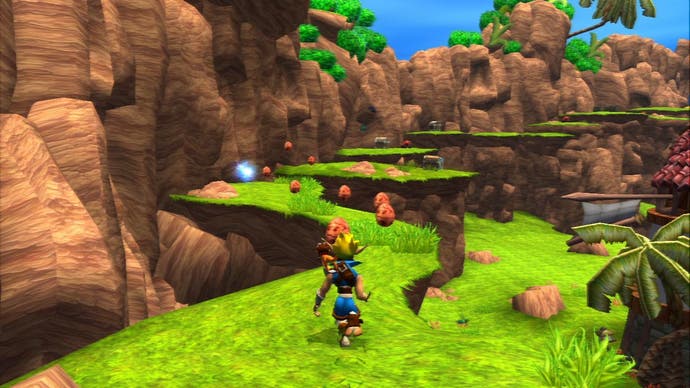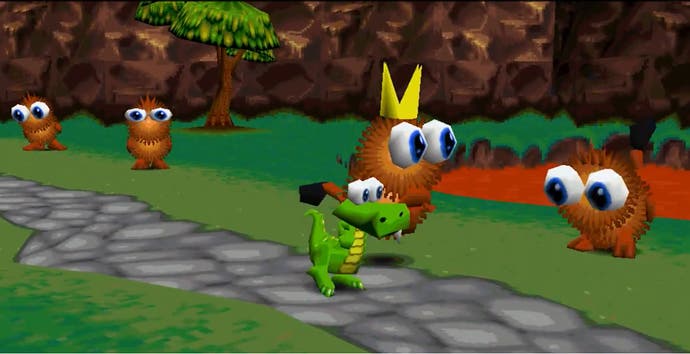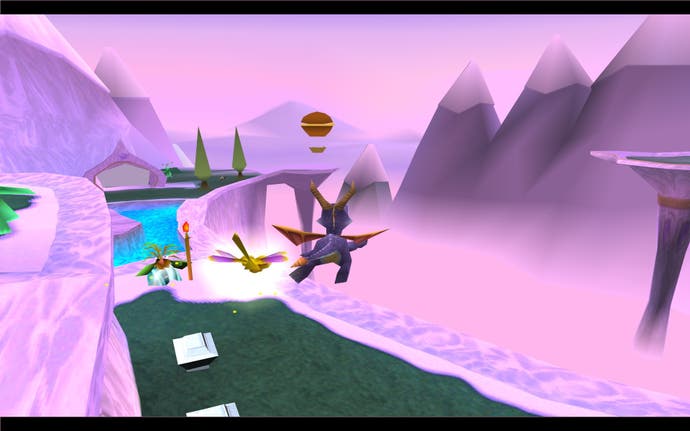The strange, timeless appeal of early 3D platformers
Shout out to my Gex.
If you were a freelance video game journalist in the mid-1990s there was one genre that you learned to both love - and massively detest. That polarising genre was the character-based 3D platformer.
There were, of course, brilliant, perhaps even legendary examples. Super Mario 64, Crash Bandicoot, Banjo-Kazooie - these games were warm, energetic and colourful, simultaneously referencing the glorious history of platform games and the wondrous new possibilities of real-time polygon rendering. It is little wonder that we're now seeing a nostalgic re-discovery of these titles, with Crash Bandicoot rebooting, Super Mario Odyssey harking back to its Nintendo 64 ancestor and of course, Yooka-Laylee, a game that lovingly updates the classic Rare titles of the nineties, like an extravagantly packaged vinyl remaster of a classic album.
But when those titles originally arrived they weren't alone. Not by a long shot. Between 1994 and 1998, game stores were battered by an array of wannabe animal platformers, all offering a familiar mix of cutesy protagonists, syrupy stories and cartoon environments. Some of these were decent games with modest legacies of their own. Spyro the Dragon from Insomniac Games was a well-liked child-friendly open-world(ish) adventure that, like Crash Bandicoot, effectively taught its studio how to make character-focused 3D games. Just as Naughty Dog went on to evolve its formula through Jak and Daxter and then Uncharted, Insomniac worked through Spyro and Ratchet and Clank to get to the Resistance series of formative PlayStation shooters.

A similar thing happened with Crystal Dynamics. In 1994, the US studio released Gex, a platformer for the almost forgotten 3DO console, which starred a gecko who could catch enemies with his tongue and climb sheer surfaces. After creating a 3D sequel in 1998 the developer took its knowledge of colourful, offbeat 3D environments and applied it to the brilliant vampire adventure Legacy of Kain: Soul Reaver and later to the Tomb Raider series.
For many teams then, the brash, bright, simplified environments of this genre, provided a welcoming tutorial on 3D design. When seminal UK studio Argonaut, started its Croc game, it was originally a tech demo for the Nintendo 64, and actually began as a Yoshi racing game. When Nintendo decided against that, the studio used its formative 3D engine to craft a character-based platformer instead. "When we started the project there was no real reference for what a platform game would play like, so we took influences from classic platformers and laid them out in 3D space," says designer Nic Cusworth, now at Sumo Digital. "The editor we built was even based on a tile system, the same way you would build a 2D game, but in 3D. This approach had its limitation but meant we could build a lot of content incredibly quickly.
"The Croc engine went on to power most of Argonauts PlayStation 1 games at the time, and some of the technology even made it through to the PS2 era. Now I look back on the tools we built with fond memories. It was a little like a 'my first game engine'. I see a lot of mobile and hand held games using the same kind of techniques. And even today when I'm building a prototype, or trying out a few ideas, I use a Croc style world builder to quickly sketch out ideas."

There were other reasons this genre was so popular at the time - and why so many platformers of the era choose anthropomorphised lead characters. First, the console industry was only just emerging from the SNES/Mega Drive era when games were still thought of as something for kids - maybe teenagers if you were lucky - and therefore concentrated heavily on fairy tale worlds and fantastical narratives. "It was a much younger demographic than it is today," says Cusworth. "I know when we were working on the game we wanted to make something parents would be really happy leaving their kids to play."
From Super Mario to Rainbow Islands to Mega Man, there was also this whole rich legacy of super bright, magical beauty to drawn from and explore on the new 32bit platforms. This was a genre built on child-like fantasy themes. "Games like Yooka, Banjo, Jak and Ratchet are all about escapism," says veteran artist Steve Mayles, who worked on Rare's N64 titles before designing Yooka-Laylee. "Anything is possible in these colourful worlds. I think animals lend themselves to exaggeration better than humans, and platformers are all about exaggerated art styles."
There were also technical constraints to think about. In the early days of the PlayStation and Saturn, developers were still getting the hang of creating 3D polygonal characters, and the hardware itself could only render so much detail without the framerate dropping through the floor. Because of this, nice, cute, relatable human characters were tough, and tended to slide straight into the Uncanny Valley - that weird point where computer generated people don't quite look realistic enough so end up being absolutely terrifying. It's something Pixar was wary of when it set out to make its first feature-length animation, Toy Story, choosing to concentrate on a cast of action figures rather than humans so that audiences would accept the lower resolution faces and expressions.

"Getting humans to look like humans with low poly/low res textures was a challenge in the 90s," says Mayles. "With a stylised animal character this is less of an issue - it's easier to work with the limitations rather than fighting them. People will argue your human doesn't look human enough, but who is going to argue your stylised bear doesn't look enough like a bear?"
The era was also seeing the re-birth of Disney as a true creative force, and contemporary movies like Little Mermaid and Beauty and the Beast made wonderful use of anthropomorphised characters to express attitudes and tell stories. We remembered how beautifully movies like Dumbo and Robin Hood had used animal types to convey specific emotions and temperaments. "It was always about driving character," says Mark Stevenson, also at Yooka-Laylee studio Playtonic. "Animals have a long history in cinema and literature of being connected to certain traits and characteristics of humans that have generally become universally accepted, so using them gives a way to quickly and easily imply characteristics visually that would be much more challenging to do with realistic human characters."
Stevenson also argues that animal characters provide in-built special abilities that players instantly understand and that provide intrinsic gameplay elements. In Croc, it's the swishing tail, in Yooka it's the chameleon's tongue and the camouflage. "These," he says, "can easily be built out into interesting mechanics that whilst completely unrealistic to the creatures in the real world players still make that connection and have that association with what is commonly known about these animals."
But here's why freelance video game journalists hated the genre as well as loved it: there were so, so many games that just hung grimly onto the coat-tails of the genre - and when it came to reviews, magazines tended not to want to handle those things in-house. Because they were terrible. As a young impressionable journo for hire in exactly this period I spent many of my weekends battling through these formulaic me-too monsters. I played Jersey Devil, in which a bat-like creature must battle an evil scientist, his mutant vegetables and the world's most erratic 3D camera. I played Chameleon Twist, in which you are attacked by ice-cream sandwiches and use your tongue as a pole vault. I played Bubsy 3D, generally considered one of the worst 3D games ever made, with an environment that looked like it had been built out of cardboard boxes by the planet's most attention deficit three-year-olds.

Some of these titles made me really sad. Often this was because they were so excruciatingly bad they forced me to confront the fact that our time on Earth is short and shouldn't be spent trying to get a reptile to pole-volt over an ice cream sandwich. Sometimes it was because of the hopes they once represented. The 1995 title Bugs! - a 2.5D platformer about a nondescript bug - was the first Sega Saturn game produced in the US, and developer Realtime Associates had hopes he could be a mascot for the console. When Steven Spielberg saw the game at the CES show in 1995 he apparently proclaimed. "This is the character! This is the character that is going to do it for the Saturn." It wasn't and it didn't. Some of these games made me sad because they were released by once great publishers desperate for one last hit. Cheesy, for example, was an appalling PlayStation platformer by Ocean one of the great powers of the 1980s Britsoft gaming scene. It follows a mouse called... Cheesy who is trapped in a mad scientist's laboratory, which is then invaded by aliens and... oh for god's sake who cares?
Well, the weird thing is, someone probably does. Though my early freelance career was marred by poor 3D platformers, most of these titles still have their loyal fans. When Toys For Bob started its Skylanders project it reanimated Spyro as a central character because it knew the character had cache with nostalgic parents.
Last year, I wrote something mildly detrimental about Croc and I was flooded with such furious replies I thought I was going to have to move into a safe house. I think character-based 3D platformers somehow weedle their way into our warmest media memories in the same way as children's TV programmes, animated movies and Dr Who actors - we unconditionally love the ones we grew up with. They have a hold on us. "There was no easy way to talk to Croc fans back in the day so I think we never really understood how loved the games were," says Cusworth. "I'm always amazed when I see some fan art, or someone speed running the game on Twitch. Over the last couple of years I've found I'm starting to work with people who are new to the industry that played Croc when they were kids!"
Platformers are among the most pure of all video game experiences. Their design celebrates the innate 'unreality' of game environments and their heroes are chosen and built for gameplay mechanics rather than narrative concerns. Every object has a specific role, every action a specific outcome, every world its own logic. Also, as a species, we love cute animals and 3D platformers have given us those in abundance. The best of them sit in our memories alongside cherished childhood toys. They are the sunny school holidays of gaming.

